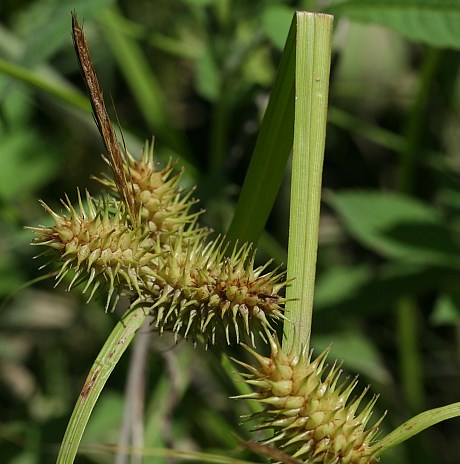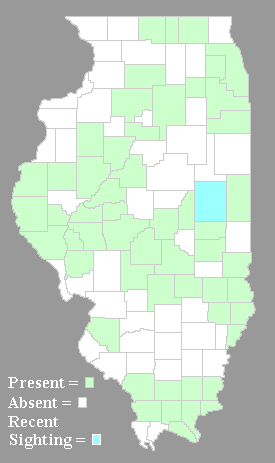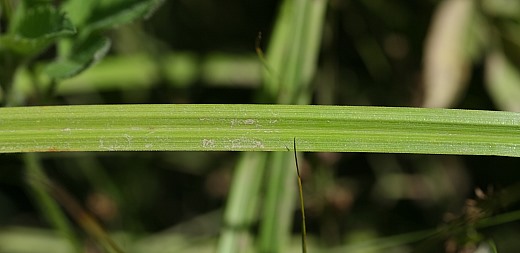Description: This perennial sedge forms a tuft of basal leaves and one or more culms up to 2½' long. Each culm is stiff, 3-angled, glabrous, and unbranched; its edges are rough underneath the inflorescence. Along the lower half of each culm, there are 1-3 alternate leaves that are ascending to widely spreading. The blades of these leaves are up to 12" long and 7 mm. across; they are light to medium green, glabrous, channeled along their midribs, and rough-textured along their margins. The outer leaf sheaths are light to medium green and glabrous, while the inner sheath is membranous and truncate to slightly concave at the mouth.

Each culm
terminates in an inflorescence up to 6" long that consists of 1-4
pistillate spikelets and a single staminate spikelet. Underneath each
of these spikelets, there is a leafy bract of variable size. The
lowermost bract is about 9" long and 5 mm. across, while the uppermost
bract is about 3½" long and 2 mm. across. The lower bracts are longer
than the inflorescence. The yellow-green to yellow-brown pistillate
spikelets are bunched together underneath the staminate spikelet; they
are ascending to widely spreading on short pedicels up to 3 mm. long
(sometimes the lowermost spikelet may nod). Each pistillate spikelet is
about 3-4 cm. long and 1½ cm. across; it is stout-cylindrical in shape
and densely packed with perigynia (100 or more). The pistillate
spikelet has a bristly appearance because of the long beaks of its
perigynia. Each perigynium is 7–8.5 mm. long and 2.5–3 mm. across; its
base is obovoid in shape (excluding the beak) and wedge-shaped at the
bottom, while its apex consists of a
long slender beak that terminates
with 2 tiny teeth. The shiny outer surface of the perigynium has
several fine longitudinal veins (about 10). Underneath each perigynium,
there
is a pistillate scale about 5 mm. long. This scale has an ovate base
with a long awn that is minutely saw-toothed. The staminate spikelet is
about 2 cm. long, very slender, and short-stalked; after shedding its
pollen, it soon becomes dark brown. The blooming period occurs during
the summer. The florets of the pistillate spikelets are
wind-pollinated. Each perigynium contains a single achene that is
2.0–2.5 mm. long and half as much across; this achene is ovoid to
slightly obovoid and 3-angled. The root system consists of fibrous
roots and rhizomes. Vegetative clumps of plants are often formed.
while its apex consists of a
long slender beak that terminates
with 2 tiny teeth. The shiny outer surface of the perigynium has
several fine longitudinal veins (about 10). Underneath each perigynium,
there
is a pistillate scale about 5 mm. long. This scale has an ovate base
with a long awn that is minutely saw-toothed. The staminate spikelet is
about 2 cm. long, very slender, and short-stalked; after shedding its
pollen, it soon becomes dark brown. The blooming period occurs during
the summer. The florets of the pistillate spikelets are
wind-pollinated. Each perigynium contains a single achene that is
2.0–2.5 mm. long and half as much across; this achene is ovoid to
slightly obovoid and 3-angled. The root system consists of fibrous
roots and rhizomes. Vegetative clumps of plants are often formed.
Cultivation:
This sedge is typically found in full sun to light shade, wet to moist
conditions, and various kinds of soil (loamy, sandy, &
gravelly). It tolerates temporary flooding.
Range & Habitat:
Sallow Sedge is occasional throughout Illinois. Habitats include
prairie swales, sedge meadows, swamps, edges of marshes, gravelly
seeps, borders of ponds and streams, and ditches. This sedge is found
in many kinds of wetlands of varying quality.
Faunal Associations:
Because the number of fauna that use Carex spp.
(Sedges) is large, only some of these fauna will be described. The
orthopteran insects Stethophyma lineata (Striped
Sedge Grasshopper) and Stethophyma celata (Otte's
Sedge Grasshopper) feed on the foliage of sedges. The following leaf
beetles (Chrysomelidae) also feed on the foliage of sedges: Donacia
porosicollis, Plateumaris aurifera, Plateumaris
diversa, Plateumaris dubia, Plateumaris
flavipes, Plateumaris fulvipes, Plateumaris
robusta, and Poecilocera harrisii (see Host
Plants of Leaf
Beetle Species Occurring
in the United
States and Canada
by Clark et al., 2004). For a list of butterflies, skippers, and moths
that feed on one or more sedges, see the Lepidoptera
Table. Several leafhoppers prefer to feed on sedges,
especially Cosmotettix spp. The nymphs of
spittlebugs Lempyron angulifera and Philaenus
parallelus suck juices from sedges while hiding in their
spittle-foam. Among vertebrate animals, the seeds/seedheads are an
important source of food to various waterfowl, granivorous songbirds,
and other birds (see the Bird Table).
Photographic Location:
A drainage ditch in Urbana, Illinois.

Comments: The most distinctive characteristic of Sallow Sedge is the yellowish appearance of its pistillate spikelets (see the upper photograph). This helps to distinguish this species from similar sedges (e.g., Hop Sedges & Porcupine Sedges). The pistillate spikelets and perigynia of Sallow Sedge are smaller in size than those of Carex lupulina (Hop Sedge) and Carex lupuliformis (Hop-Like Sedge). Sallow Sedge also differs from the similar Porcupine Sedges (Carex comosa & Carex hystericina) by having larger perigynia, and its pistillate spikelets nod less than the pistillate spikelets of the latter two species. Another similar species, Carex baileyi (Bailey's Sedge), has similar pistillate spikelets that are bunched together on short pedicels. However, the perigynia of Bailey's Sedge are shorter than those of Sallow Sedge and its pistillate spikelets (about 1/3–1/2" or 8-12 mm. across) are more narrow than those of Sallow Sedge (about 1/2–2/3" or 12-17 mm. across).